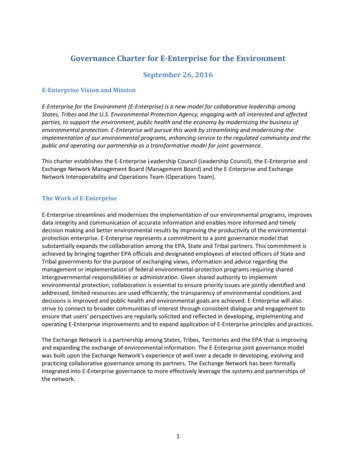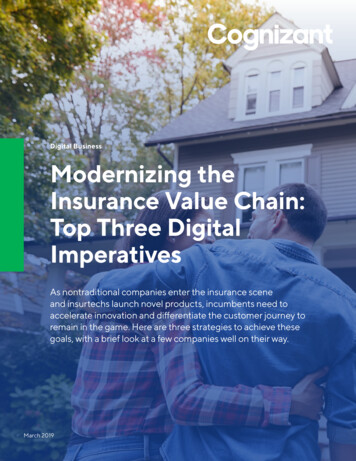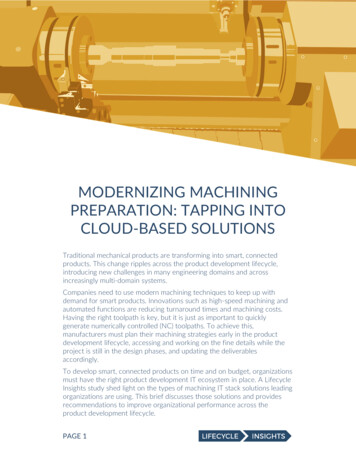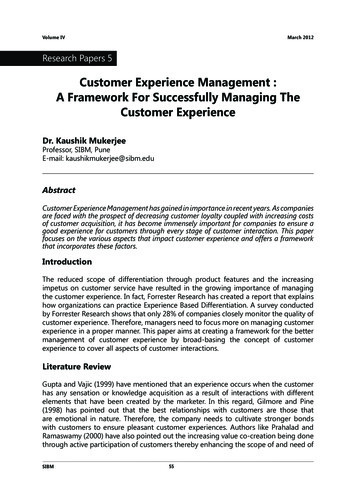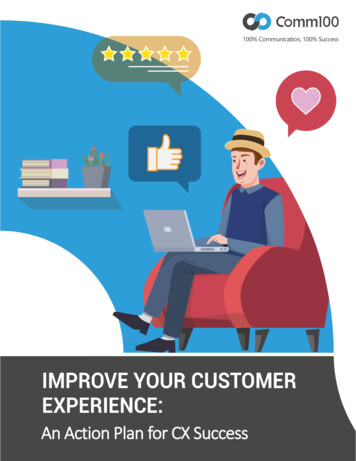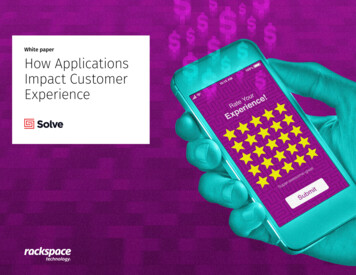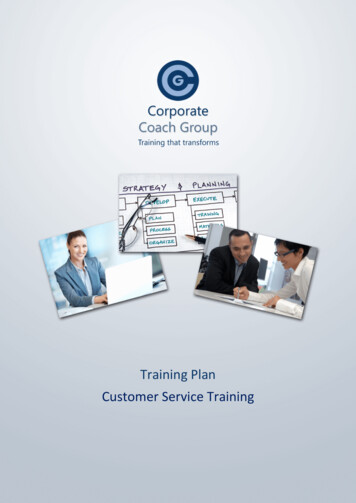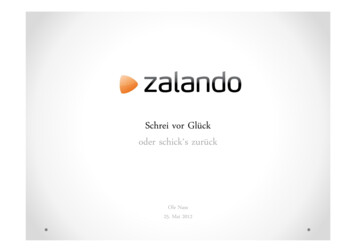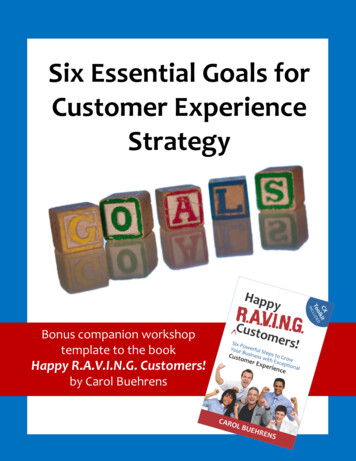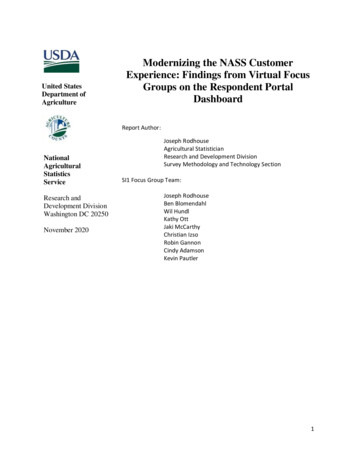
Transcription
United StatesDepartment ofAgricultureModernizing the NASS CustomerExperience: Findings from Virtual FocusGroups on the Respondent PortalDashboardReport ch andDevelopment DivisionWashington DC 20250November 2020Joseph RodhouseAgricultural StatisticianResearch and Development DivisionSurvey Methodology and Technology SectionSI1 Focus Group Team:Joseph RodhouseBen BlomendahlWil HundlKathy OttJaki McCarthyChristian IzsoRobin GannonCindy AdamsonKevin Pautler1
Table of ContentsI. Executive Summary .3II. Recommendations .41. Introduction .62. Visualizing the Customer-centric Web Dashboard .73. Virtual Focus Group Methodology . .144. Virtual Focus Group Results . 195. Conclusions and Recommendations . .25i. References . .27ii. Appendix A (Discussion Guide). . .29iii. Appendix B (Narrated Video Transcript) . 36iv. Appendix C (Virtual Focus Group Invite Text) . .382
I. EXECUTIVE SUMMARYThe National Agricultural Statistics Service (NASS) is undertaking an effort to modernize theway it collects data from—and shares data with—agricultural producers on the web.Furthermore, NASS hopes that modernization efforts will improve the customer experience forproducers engaging with the Agency on the web. The work to improve the Agency’s onlinepresence is spearheaded by the recently formed Strategic Initiative 1 (SI1) Team, which has putinto motion the creation of a new customer-centric, web dashboard to accomplish themodernization goal.The concept of a customer-centric dashboard is simple. Provide a single online resource whereusers can access all the tools they need to do business. Conceptually, the dashboard will provideproducers with everything they need to make better and more informed decisions for theiroperations. For reporting data to NASS, the survey features of the dashboard are conceptuallyderived to reduce respondent burden by leveraging previously reported data, secondary-sourceddata, and other data. The overall effect, improved customer satisfaction with NASS products andservices on the web.To accomplish the goals of the SI1 Team, a contractor was hired to bring the vision of the webdashboard to fruition. With the help of the contractor, prototypes of the dashboard were built.However, before making the prototypes operational, the SI1 Team sought respondent feedbackon the concepts and features of the dashboard. As a result, a series of focus groups wereconducted with agricultural producers in September 2020. In total, four focus groups with tentotal participants partook in the research. Despite the relatively small sample size, a plethora ofqualitative insights into producers’ perceptions of the dashboard were realized.Overall, the focus group participants viewed the dashboard favorably, and most indicated awillingness to use the dashboard or at least try it out. Participants liked the cleanliness of thedesign and the organization of the features (e.g., the reports and surveys tabs). Despite this, notmany participants viewed the dashboard in its current form as necessarily solving the biggestproblems they face when engaging with NASS on the web. For example, even thoughparticipants thought the “Surveys” page was useful, NASS survey questions and reports werestill viewed as burdensome to complete.The focus group participants had many suggestions for actions NASS can take to improve theircustomer experience. For example, participants felt NASS should do more to increase theagricultural population’s awareness of the agency and the relevance and utility of its data. Manyof the participants did not feel like they knew enough about NASS and the relevance of its datafor their operations. This lack of knowledge was often cited as a reason why they did not useNASS as their first source for data gathering, and hence, tempered their expectations for howuseful they would find the new web dashboard. In total, the participants offered multiple,specific recommendations for NASS to adopt that they indicated would make them more likelyto find the dashboard useful and, therefore, more likely to use it. The purpose of this report is todetail those focus group findings and provide a summary of recommendations NASS mayconsider as it moves forward with the development of the dashboard to improve the Agency’scustomer experience.3
II. Recommendations for NASS and the Development of the Customer-centric DashboardRecommendations for NASS based on Focus Group Feedback NASS should make a concerted effort to market the dashboard to producers. Raisingawareness of the dashboard and why producers should use it, may increase the likelihoodof that producers would use the tool.NASS should optimize the dashboard for smartphones and tablets. Many participantsnoted that producers spend most of their time, and conduct most of their business, overtheir smartphones.The dashboard should have an easily recognizable help button, or FAQ feature.The dashboard should have instructional videos, both for how to use the dashboard, andmore importantly, for how to fill out and complete online reports they are asked toprovide data for.The dashboard should have a “Definitions” feature that provides clarifications forcomplex questions in the surveys that producers are asked to complete.The dashboard should have a calendar of important report dates that are relevant to theproducer.The dashboard should be accessible by a single username and password that can be usedacross all USDA websites.The dashboard should allow users to select and customize notifications and reminders(such as email reminders, preferred contact methods and times).Producers would like the data they report to other USDA agencies, such as the FSA, tolink to their dashboard page.The dashboard should provide an aggregation tool for all of the data producers report.The dashboard should automatically feed forward the data they reported in past surveysinto future or current web surveys.The dashboard should have a feature that allows users to download paper copies of theweb surveys they are asked to complete.The dashboard should have the capability of showing users data by local and regionallevels, as well as other characteristics (e.g., operation size).The dashboard should show data that is “real-time” or close to real-time (e.g., updateddaily).In addition to the “Trending” reports feature, the dashboard should have a feature thatspecifically highlights data NASS thinks is imperative for farmers to know (e.g., pointsout what is crucial data and information).4
5
AbstractThe National Agricultural Statistics Service (NASS) conducts hundreds of surveys annually,producing numerous reports and data from the completed responses. However, response rates havedeclined in recent years, a trend that is happening across all survey research organizations. Thereasons for declining response rates vary, but there are a number of actions organizations can taketo mitigate nonresponse. One way to do this is to increase customer satisfaction and engagementwith your organization. As a result, NASS is seeking to better serve its customer base by buildinga new customer-centric web dashboard that will function as a “one stop shop” for farmers thatserves important business needs, such as gathering and reporting crucial information. This reportdetails the findings from focus groups, conducted with NASS’s target population on the conceptof the dashboard and prototypes of its design. The results of the focus groups highlight both broadand specific actions NASS can take to improve and modernize the customer relationship withregard to the dashboard and among the agricultural population overall.Keywords: Focus Group, Dashboard, Data, Information, Surveys, Reports1. INTRODUCTIONThe National Agricultural Statistics Service (NASS) is currently undertaking an effort tomodernize the way it collects data from—and shares data with—agricultural producers on theweb. Furthermore, NASS (the Agency) hopes these modernization efforts will improve thecustomer experience for producers engaging with the Agency online. The work to improve theAgency’s online presence is spearheaded by the recently formed Strategic Initiative 1 (SI1)Team. The SI1 team initiated the creation of a new customer-centric web dashboard toaccomplish the modernization goal.Historically, NASS has introduced a variety of different tools and systems to modernize its datacollections efforts. Systems have arrived at different times, workarounds were developed to linkdisparate systems, and new training, administrative, and data collection tools were implementedto fill the needs of NASS staff and data providers. The result has been a data collection processthat is somewhat fragmented. For web survey respondents, fatigue from the authenticationprocess, and the necessity of visiting multiple USDA sites to complete a single survey became acommon complaint. Respondents often feel that finding survey results and reports is acumbersome process. Thus, they often fail to see the value in the surveys they completed andthe resulting data and reports.Over the years, a common theme has been heard from respondents regarding their view on datacollection at NASS. Their concerns were echoed once again in the findings recently released(Pick et al. 2018) by the Farmers’ Feedback Sub-team of the Response Rate Research Team.When asked “How can NASS better serve you, the farmer or rancher” responses included “Makereporting easy for me”, “Make questions/questionnaires easy to answer”, and “Use data I’vepreviously reported to either NASS or other USDA agencies.” The consistent theme in theseresponses from producers over time, along with response rate declines and increasing data6
collection costs, requires a novel solution. The creation of a customer-centric web dashboard, theSI1 Team believes, is a requisite step in this direction.The concept of a customer-centric dashboard is simple: provide farmers with a “one stopshopping” experience where users can access the tools they need to do business. For respondentsthis will mean a single point of entry to complete surveys leveraging previously reported data. Itwill provide links to other frequently used sites as well as new data dissemination andvisualization tools allowing them to better understand the value in reporting. Provide a centralpoint of contact with NASS that allows producers to efficiently report data to NASS as well asaccess producer-specific analytics, based on the type of enterprise or household derived fromNASS estimates and external data sources. The interface will help producers make better andmore informed decisions for their operations. It will also reduce respondent burden by leveragingpreviously reported data, secondary-sourced data, and geospatial data. The overall effort is aimedat improving the customer experience and data collection process to make reporting data easierfor the respondents, allowing them to report their data in a convenient way at a convenient time.To help achieve its vision and operationalize the concept behind the customer-centric webdashboard, NASS hired a private contractor. Together, the SI1 Team and the contractor began byvisualizing what the web dashboard could look like. This was an important initial step beforeactual work on an operational form of the concept began. The contractor ultimately produced aprototype of the dashboard, which included four different web pages within the dashboard thataddressed the key conceptual domains outlined above (snapshots of the dashboard designsappear in section 1.1 of this report). Once the initial prototypes were ready, the SI1 team thenturned its attention back toward the dashboard’s target audience—agricultural producers—tosolicit feedback in the form of focus groups.The purpose of this report is to detail the results of the focus groups that highlight importantproducer perceptions of the dashboard. These results, as well as other producer perceptions ofchallenges and opportunities with reporting and using data, lead to specific recommendationsthat NASS should take to further improve the customer experience (both with the dashboard andmore generally). These results are presented at the conclusion of this report.2. VISUALIZING THE CUSTOMER-CENTRIC WEB DASHBOARDTo help achieve its vision and operationalize the concept behind the customer-centric webdashboard, NASS hired a private contractor. After multiple rounds of talks around visualizingthe web dashboard, the contractor produced a set of prototypes of the dashboard’s web pagedesigns. The overall design contains four web pages within the dashboard that a producer couldvisit depending their reasons for visiting the site: a “My Dashboard” page, a “Surveys” page, a“Reports” page, and a “My Profile” page. Images of the prototypes of each of these pages thatmake up the dashboard appear below in this section of the report. Figure 2.1 below exhibits theprototype of the “My Dashboard” page – the first page a producer would see upon logging intotheir customizable web dashboard. Figure 2.2 displays what the producer would see on the lowerhalf of that first page. Figure 2.3 is an image of the “Surveys” page, and Figure 2.4 is avisualization of what starting a survey on that page would look like. Figure 2.5 shows the7
prototype of the “Reports” page, and Figure 2.6 is the rendering of what the producer’s “MyProfile” page would entail.When an agricultural producer enters their NASS customer-centric web dashboard, the first pagethey would see is their “My Dashboard” page. This page, visualized in Figure 2.1 below, isdesigned to reflect what a producer would see if they customized it to be informative for theirspecific operation.Figure 2.1 Dashboard Prototype: “My Dashboard” PageThe producer can see the weather forecast for their operation’s area, the current prices for thecommodities the operation produces, the NASS surveys they have been asked to complete,NASS reports relevant to their operation, and other analytics that can track things like theircommodity prices over time compared to a national average. This “My Dashboard” page is thefruition of NASS’s desire to provide agricultural producers with a “one stop shop” where theycan provide and acquire data for their operations.8
Figure 2.2 displays the lower half of the “My Dashboard” page a producer would see. The “Data& Statistics” portion of this page is designed to provide information back to producers likelyimportant to their operation. This improves the two-way exchange of information between NASSand its data providers, an importance goal of NASS. While producers are able to provide data toNASS in the surveys they are sampled in, NASS can provide data back to producers in the formof charts of data points they may be interested in, such as commodity prices. In the Figure 2.2,the example is of NASS providing data back to the producer that compares their operation’scommodity (in this case, peanut) prices and stocks to the national average over time. With thistool, producers would get information that is often helpful for operational decision-making.Figure 2.2 Dashboard Prototype: “My Dashboard” Page – ContinuedFigure 2.3 below shows the visualized idea behind the goal of making responding to NASSsurveys on the web easier and more efficient for producers. This page is called the “Surveys”page in the web dashboard prototype. The prototype displays three main functions for producers:1) access to the new surveys they are being asked to complete, 2) access to the surveys they havealready begun working on, but not yet completed, and 3) a view of a complete list of surveysthey have already successfully completed. For the “New” surveys, producers can easily navigate9
to the survey by simply clicking on the “Start” icon at the right of the screen. This feature is anattempt to make the authentication process much simpler than the current NASS survey webauthentication process, hopefully reducing the burden on the producer when trying to begin asurvey. Furthermore, the “In-Progress” icon helps show producers that they can save and exit asurvey if they cannot complete it all in one sitting.Figure 2.3 Dashboard Prototype: “Surveys” PageThe list also helps producers keep track of the surveys they are unable to complete in one sitting,which they can continue working on by clicking the “Resume” button found next to each surveystill in-progress. Along similar lines, the complete list of “Completed” surveys allows producersto access their answers to previous surveys. This can be hugely beneficial to producers who relyon their historical data to help them figure out their answers to the surveys they are responding tocurrently.10
Figure 2.4 is an illustration of what happens when the producer clicks the “Start” icon in the“Surveys” page of the web dashboard. Rather than taking them to a new webpage away from thedashboard location, this rendering envisions something more like a pop-up screen that overlaysthe web dashboard page. This allows the respondent to begin completing the survey, while stillbeing able to get back to their dashboard when they exit the survey.Figure 2.4 Dashboard Prototype: “Surveys” Page – Completing a Web SurveyThis illustration of the web survey design includes a user-friendly design that may be moreappealing to survey respondents than what is currently available. There are helpful informationicons, such as a progress indicator. There is also information to remind respondents about thecommodity they are reporting, the date by which they must submit their answers, historicalpricing data that may help producers when thinking about their answers, and a “Resume Later”button if they need to finish later.Figure 2.5 below details the current vision for the “Reports” page of the web dashboard. Thispage is designed to allow producers to find and access NASS data and reports that are of interestto them and their operation. Particularly, newly released data and other reports that are trending11
(e.g., popular) among producers nationwide. If the producer has multiple operations they areinvolved with, they can click the dropdown “Select Operation” to change the operation for whichthey would like to see reports.Figure 2.5 Dashboard Prototype: “Reports” PageLastly, Figure 2.6 below illustrates the dashboard prototype for a customizable respondentprofile page called “My Profile.” On this page, the producer can fill out information aboutthemselves and their operation. The producer can write a “Bio” about who they are, what theyproduce, or anything else such as what they are hoping to accomplish by joining this site (e.g.,“I’m a Colorado-based peanut farmer. I provide peanuts in the local area and am looking toexpand my operation outward.”). This page is also where the producer can provide their personalor operational contact information, key personnel associated with the operation, associations ormemberships they or the operation belong to, and URLs pointing to their operation’s websites.As mentioned earlier, the goal of each of the pages in the customer-centric web dashboard is tocreate more engagement between NASS and agricultural producers around the country on theweb. NASS and producers have somewhat of a symbiotic relationship: NASS relies on producersto provide data so NASS can create timely and important statistics around all things agriculture,and many producers rely on NASS’s reports to help make important decisions on theiroperations.12
Figure 2.6 Dashboard Prototype: “My Profile” PageDue to this important symbiosis, it was essential to the SI1 Team that producer feedback on thedashboard concept was sought. Important themes and insights from their feedback could then beused to improve and enhance the web dashboard concepts and designs. The following sections ofthis report detail the methodology, results, and conclusions the focus group research conductedfor this purpose.3. FOCUS GROUP RESEARCH METHODOLOGYFocus group research is a well-established methodology in the business survey context (Snijkers2002; Phipps et al. 1995; Gower 1994; Palmisano 1988). Focus groups are often conducted atany (or all) stage(s) in the development, testing, or evaluation of projects, products, and services.In the development stage, the goal is to understand respondent perceptions of the concept beingstudied, including respondent interpretations of the concept, how they define attributes of theconcept, and how the concept relates to their business activity (Snijkers et al. 2013). Focusgroups during the testing and evaluation stages are two sides of the same coin. At these stages,focus groups react to a draft of the product or service (such as a questionnaire, or in this case – acustomer-centric web dashboard). Feedback regarding the appropriateness, usefulness, andcompatibility with business activities and other general reactions (such as to the design) are13
given in the conduct of this research with respondents (Snijkers et al. 2013; Snijkers and Luppes2000; Babyak et al. 2000; Eldridge et al. 2000; Gower 1994; Carlson et al. 1993). The conduct ofthe focus groups for the customer-centric web dashboard included elements from all three of thestages listed here.Procedures for conducting focus groups abound. Two recommended texts include Kreuger andCasey (2000) and Morgan (1997). Generally, focus groups are semi-structured discussionsamong a small group of people (8-12 participants) from a target population around a particularset of topics (Snijkers et al. 2013). Focus groups are led by a trained moderator, who facilitatesthe semi-structured discussion by first reading standardized questions from a discussion guide,and then using neutral or reactive probes to get participants to respond, react, or dive deeper intocertain points made by participants in the ensuing discussions (Snijkers et al. 2013). The essenceof the moderator is to encourage open discussion among the group while ultimately guiding it ina direction that is meaningful for the research topic (Snijkers et al. 2013). Typically, the directionof the focus group follows a funnel approach, where the discussion begins more broadly aroundthe topic or concept of interest and then gradually gets more specific as the discussion advances(Snijkers et al. 2013).The SI1 Team largely followed the above procedures. A focus group discussion guide structuredin the funnel approach fashion was developed, and experienced focus group moderators wererecruited to facilitate the discussions. The initial plan was to conduct two in-person focus groupswith 8-10 participants per focus group with producers in the Northeast and Upper Midwest in thesummer of 2020. However, the COVID-19 pandemic caused the SI1 Team to abandon the inperson focus group plans for safety concerns. Instead, the SI1 Team pivoted towards conductingvirtual focus groups. Virtual focus groups are focus groups conducted via a remote meetingsoftware (e.g., Zoom, Skype, WebEx), where each participant in the groups joins the meetingfrom an electronic device (e.g., desktop, laptop, tablet, or smartphone). Participants can join fromtheir home, place of work, or any other place where they are able to connect to the internet andthe location is convenient for them. Essentially, focus group participants are not present in thesame physical location (as in in-person focus groups), but are instead each participating fromseparate physical locations in the same “virtual” room.The change from in-person to virtual focus groups brought on other considerations as well. Forone, the size (number of participants) of each focus group was changed from 8-10 to 4-6.Although it is unknown whether there is established literature regarding optimal virtual focusgroup sizes, members of the American Association for Public Opinion Research (AAPOR) whohad experience conducting virtual focus groups recommended limiting the number ofparticipants to four to six in discussion threads on the association’s email list serve. This beingNASS’s first foray into virtual focus group data collection, the SI1 team thought it prudent tofollow the advice shared by members of AAPOR. The benefit being that, if any one groupexperienced technical, or other, difficulties during the focus group, then any adverse effectswould impact fewer participants and the quality of data collected from those participants. Inaddition, limiting the virtual focus group sizes to 4-6 was thought to mitigate the chance oftechnical difficulties or other disruptions that could influence the data being collected.Ultimately, the SI1 Team planned to conduct four virtual focus groups with four to sixparticipants per group, with a goal of obtaining data from about twenty participants in total. In14
addition, the number of SI1 Team members in the virtual focus groups was limited to three: onemeeting host, one moderator, and one note taker. The meeting host made sure the recruitedparticipants could access the meeting and handle any technical troubleshooting that arose, whilealso kicking off the meeting with an introduction about what to expect. The moderator guided thediscussion, and the note taker was a silent observer that took notes during the discussion.The decision to proceed with virtual focus groups created a new challenge regarding how toshare the prototypes of the customer-centric web dashboard to the participants. The in-personfocus group’s plan was to share print prototype copies with each participant and have them spend5-10 minutes looking over and digesting what they were seeing, followed by pointed questioningabout their perceptions of the concepts and attributes of prototypes. However, this would bedifficult to accomplish in a virtual setting. The SI1 Team decided that a short video narration ofthe prototypes shared during the virtual focus groups by the meeting host could help overcomethis challenge. Furthermore, using a narrated video had the advantage of providing every focusgroup participant with the same research stimuli (reliability), and likely increased the chances forparticipants to comprehend the prototypes in the way the SI1 Team meant them to be interpreted(validity).The final version of the discussion guide can be found in Appendix A of this report. A transcriptof the video narration of the focus groups can be found in Appendix B. Copies of the email textwith the secure USDA government Zoom account meeting link for participants to access eachfocus group can be found in Appendix C. Table 3.1 below summarizes specific features of thevirtual focus group methodology.Table 3.1 Summary of the SI1 Customer-Centric Web Dashboard Focus Group FeaturesFeaturesDescriptionVirtual meeting conducted via USDA governmentSettingZoom account belonging to the Southern PlainsRegional Field Office (RFO)Focus group length120 minutes maximumNumber of total desired participantsNumber of desired participants ineach focus group sessionNumber of desired focus groupsessionsNumber of recruited participantsNumber that participatedParticipant RFO domains18 to 204 to 64 to 51810Participants were recruited by the Upper Midwest andNortheastern RFOs among agricultural producers intheir respective domains15
Focus group accessParticipants and SI1 staff were individually emailed asecure, unique link generated by the SOR Zoom.govaccountNumber of SI1 staff per focus groupTotal of three: one host, one moderator, one note takerRecorded meetingsDiscussion Guide formatDiscussion Guide lengthModeration styleType of data collectedEach virtual focus group was video recorded using theZoom meeting software (each participant signed avideo recording consent form)Funnel Approach beginning broadly with underlyingconcepts to more specific questions regarding featuresof the customer-centric web dashboard36 questions (excluding scripted probes)Semi-structured: Moderators follow the discussionguide, but encourage and foster open discussionamong the participants using proactive or reactiveprobesQualitativeOf the 18 recruited participants, 10 were present for the focus group session they were assigned,for a participation rate of approximately 56 percent. There were two participants present in thefirst focus group, one participant present in the second, three participants present in the third, andfour participants present in the fourth. Due to timing considerations, coordination, andrecruitment for a fifth focus group were abandoned to avoid delays in proceeding with revisionsto the customer-centric web dashboard. Lastly, each of the ten participants signed videorecording consent forms prior to data collection, in order to record (via Zoom.gov function) eachsession. The recordings are advantageous in that they can be continually referenced asmodifications to the customer-centric web dashboard are developed.The discussion guide was designed to get producers to talk about some of the themes and keyconcepts underlying the development of the customer-centric web dashboard. As mentionedearlier1, the development of the dashboard was founded on the idea of providing a “one stopshop” where producers could access everything they need (from a data perspective) to dobusiness and respond to survey requests. Therefore, the discussion guide aimed to deconstructthese ideas through a series of questions that touched on particular themes underlying NASSideas to enhance the customer experience with the web dashboard.1The idea being NASS would make it easier for producers to find the data they need, lower theburden of accessing and responding to surveys, and overall improve their satisfaction withinteracting (getting data from or providing data to) NASS online. The
of the dashboard and prototypes of its design. The results of the focus groups highlight both broad and specific actions NASS can take to improve and modernize the customer relationship with regard to the dashboard and among the agricultural population overall. Keywords: Focus Group, Dashboard, Data, Information, Surveys, Reports 1. INTRODUCTION


